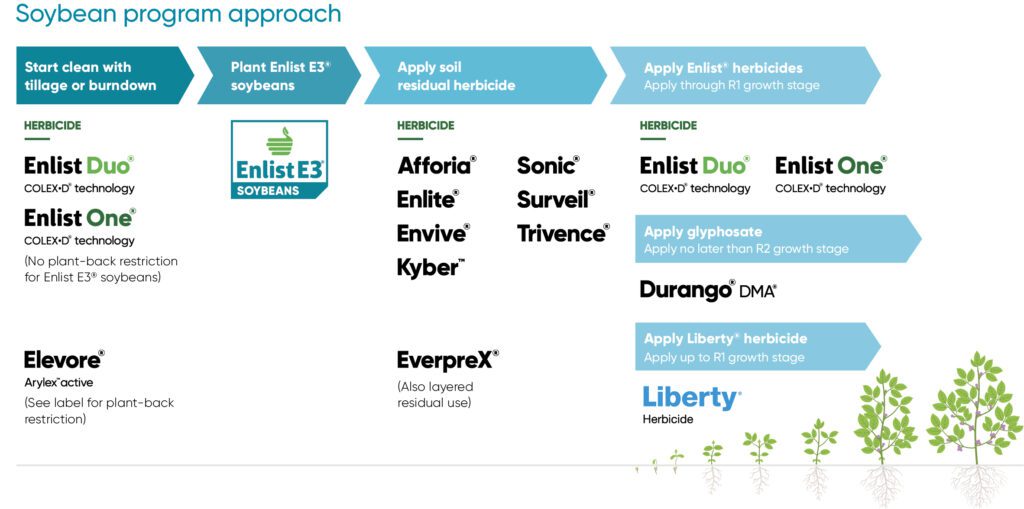Easy-To-Use, Exceptional Weed Control That Provides an Economical Edge
 Enlist® corn gives you the most advanced herbicide-tolerant trait technology on the market—enabling exceptional weed control with flexible options. The Enlist corn trait will be stacked with next-generation corn rootworm trait technology (when commercially available) to form Vorceed™ Enlist® corn, providing above- and below-ground insect protection, and PowerCore® Enlist® corn technology, providing above-ground insect protection, with both structured refuge and soon-to-be-available integrated Refuge Advanced® options.
Enlist® corn gives you the most advanced herbicide-tolerant trait technology on the market—enabling exceptional weed control with flexible options. The Enlist corn trait will be stacked with next-generation corn rootworm trait technology (when commercially available) to form Vorceed™ Enlist® corn, providing above- and below-ground insect protection, and PowerCore® Enlist® corn technology, providing above-ground insect protection, with both structured refuge and soon-to-be-available integrated Refuge Advanced® options.
One system stands alone ─ get the weed control that you deserve.
Tolerances
- 2,4-D choline & glyphosate tolerances enable the use of Enlist One® and Enlist Duo® herbicides
- Glufosinate tolerance enables the use of Liberty® herbicide for additional flexibility and control
- FOP tolerance enables the use of Assure II herbicide (quizalofop ) for postemergence grass control and control of volunteer non-Enlist corn in Enlist corn fields.
Wide application window
- Enlist® herbicides on Enlist corn broadcast applications: Up to V8 or 30” corn
- Drop nozzles: up to 48” corn
- Fewer plant-back restrictions with Enlist corn means you get more rotation flexibility compared with other burndown and postemergence herbicides
- No calendar cutoff dates
Enlist Duo® herbicide – Complete convenience
- Convenient proprietary blend of 2,4-D choline and glyphosate
- Two sites of action work together to deliver control of yield-robbing weeds and help prevent resistance
Enlist One® herbicide – Additional tank-mix flexibility
- Straight-goods 2,4-D choline with additional tank-mix flexibility
- Provides additional tank-mix flexibility with other herbicides, fungicides and insecticides, allowing for a customized weed control program to fit each farm
On-target application
- 90% less drift than traditional 2,4-D: The drift reduction from Colex-D® technology combines with low-drift nozzles to cut drift by as much as 90% compared with traditional 2,4-D
- 96% less volatile than 2,4-D ester: Near-zero volatility—up to 96% less than 2,4-D ester—helps keep Enlist herbicides in place and improve control
Apply with confidence to take down the toughest weeds, including:

1 May require a broader management plan including timely application and use of a soil residual herbicide.
Use Enlist® Herbicides as the Cornerstone of Your Program Approach
You’ll have the greatest success in weed management if you use an Enlist® herbicide as part of a program approach for weed control in Enlist® crops. This improves weed control, reduces weed competition during key stages of crop growth and helps manage herbicide resistance.
“Selecting a solid broad-spectrum residual to add in your Enlist weed control program is an excellent decision,” said AgVenture Soybean Product Manager Jeff Shaner. “There are many products out there that will kill weeds, but they do not all behave the same.”
Shaner encourages two keys to remember when selecting your residual products:
- Choose a residual that is crop safe for your current soybean fields
- Choose a residual that will have limited carry-over concerns for next year’s crop
If you have any questions about the Enlist program approach, talk with Shaner or your local AgVenture Yield Specialist to learn the best ways to align herbicide plans with your Maximum Profit System plan of action.
Key items to remember:
- Enlist herbicides can be used in burndown, preemergence and postemergence on crops with the Enlist® trait.
- Enlist herbicides are rainfast within four hours.
- Up to three applications may be made per season (2 pt./A per application for Enlist One® herbicide or 4.75 pt./A per application for Enlist Duo® herbicide, where consistent with runoff management practices)
- One application in burndown or preemergence
- Up to two applications postemergence, at least 12 days apart
- Always use a true broad-spectrum soil residual herbicide1 in your weed management plan.
- Consider using a layered residual, such as a Group 15 herbicide (i.e. S-metolachlor, pyraxasulfone, acetochlor), in your post passes for longer-lasting weed control.
Applying an Enlist® Herbicide in a Tank-Mix with Other Products
The application window for an Enlist® herbicide offers opportunities for tank-mixes with other qualified products, such as other herbicides, insecticides, fungicides, micronutrients and adjuvants.
Key items to remember:
- A tank-mix of an Enlist herbicide and other qualified herbicides allows applicators to spray multiple sites of action on tough weeds.
- For pigweed, waterhemp and kochia pressure, farmers should consider a tank-mix of Enlist One® herbicide + Liberty® herbicide, the preferred glufosinate tank-mix partner with Enlist One.
- For heavy grass pressure and glyphosate-susceptible broadleaves, farmers can either use Enlist Duo® herbicide, a convenient blend of 2,4-D choline and glyphosate, or Enlist One + glyphosate.
- Layering residual herbicides as part of a tank-mix with Enlist herbicides helps provide season-long control of tough broadleaf weeds and grasses.
- Only use tank-mix partners listed on EnlistTankMix.com for every application of Enlist herbicides.
- Farmers and applicators can select from many qualified ammonium sulfate (AMS) products and defoamers, as well as many other adjuvant options, listed on EnlistTankMix.com.
Tank-mix sequence procedures:
- Start with a clean sprayer before mixing a load with Enlist One or Enlist Duo herbicide.
- Begin with half-full tank of water carrier.
- Begin agitation and continue throughout mixing process.
- Add products one at a time, in the following order:
- AMS/water-conditioning agents
- Preslurry water-soluble packets
- Wettable powders/dry flowables
- Compatibility agents
- Liquid flowables
- Capsule suspension (CS) or suspension emulsion (SE)
- Emulsifiable concentrate (EC)
- Such as S-metolachlor
- Soluble liquids
- Glufosinate products
- Glufosinate products, including Liberty® herbicide
- Enlist Duo herbicide at 4.75 pt./A or Enlist One herbicide at 2 pt./A
- Crop oil concentrate (COC), methylated seed oil (MSO), non-ionic surfactant (NIS), other adjuvants
- Top off with water carrier
Note on mixing with glyphosate products: When mixing with Enlist One herbicide, do not pour glyphosate products into the tank or inductor at the same time as Enlist One and do not allow concentrated products to come into contact. Add products one at a time, allowing enough time for recirculation between additions of each separate product. Failure to add products one at a time, lack of sufficient water during mixing or not allowing sufficient agitation may result in salting out.

